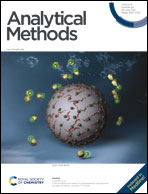Sulfur doped MoO2 hollow nanospheres as a highly sensitive SERS substrate for multiple detections of organic pollutants†
Abstract
The residual organic pollutants in the environment do great harm to the human body and ecological environment. The surface-enhanced Raman scattering (SERS) technique has the characteristics of a simple pretreatment method, rapid detection, high sensitivity, high specificity and great stability in the detection of organic pollutants. In this study, sulfur-doped MoO2 nanospheres (S-MoO2) with a hollow structure were synthesized by a simple hydrothermal reduction of MoO3 using ethanol as a reductant and thiourea as a dopant source. Profiting from the S atom doping, MoO2 manifests high SERS sensitivity to model organic pollutants such as rhodamine B (RhB), rhodamine 6G (R6G) and methylene blue (MB) with detection limits as low as 10−9, 10−10 and 10−8 M, respectively. A maximum enhancement factor (EF) of 6.2 × 107 is obtained with R6G molecules on S-MoO2 (2 wt%). Based on the experimental results and theoretical calculations, the high SERS sensitivity can be attributed to the enhanced plasmonic effects of MoO2 due to the electron-rich S atom doping, which lead to the strong electromagnetic coupling between substrates and target molecules. This study provides a new method for enhancing the SERS performance of MoO2 and this method may also be applicable to other non-noble metal semiconductors.



 Please wait while we load your content...
Please wait while we load your content...